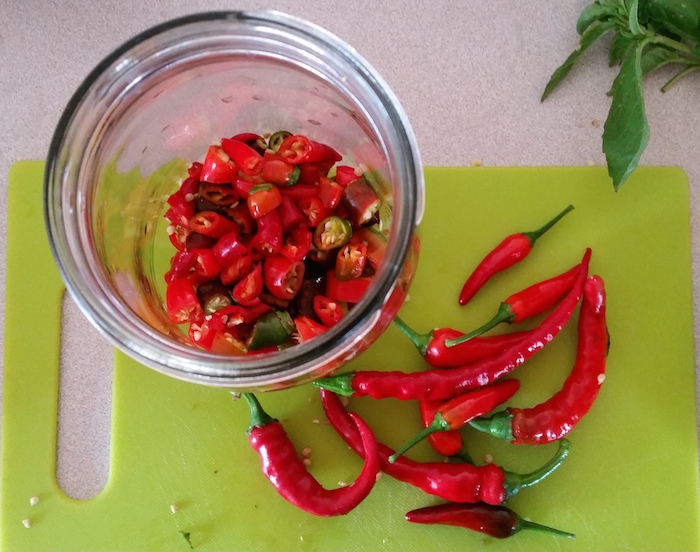When I moved to the farm after 13 years of living in the city, my grandmother suggested I start small. You know, small garden, only a few chickens, don’t bite off more than you can chew…I didn’t really listen. Maybe I should have. But now, almost three years into my prairie farm life, I think it might be too late to heed her wise advice…
Spill the beans is a weekly column chronicling my attempts at a self-sufficient life on this small prairie farm.
***

It’s hot. Like, really, super melt-your-face-off-if-you-even-think-about-going-outside hot. And so, canning is on hold, despite the fact that I have paper boxes full of ready-to-use tomatoes that are begging to be turned into sauce or salsa or ketchup, and despite the fact that I have air conditioning, I just can’t justify turning on my stove to cook up tomatoes or turning on my oven to sterilize jars.
And so this presents us with the unique opportunity to work on our fermenting projects. No cooking required.
Last year, my parents traveled through Red Wing, the unassuming Minnesota town well-known for producing good quality footwear and lesser known for making equally good quality crockery. I kindly requested, and received, a two-quart crock. And it’s a beauty. I’ve used it to ferment vegetables (which didn’t turn out but that wasn’t the crock’s fault as the crock did its job beautifully), ginger syrup to make homemade ginger ale and, currently, to ferment apple cider vinegar.

Basically, fermenting is a method of preservation that requires a lot of patience and the ability to get over one’s fear of bacteria. You see, fermenting takes time and a watchful eye. You can’t prepare your ferment and forget about it. There is always the risk of mould (like the tomatoes I started fermenting that suddenly turned into the whitest, mouldiest smelliest lump of tomatoes you ever did see – which were promptly thrown onto the compost pile). And the time it takes something to ferment is varies wildly, depending on the temperature of the place in which you are fermenting, the water you use, where the food being fermented is from, how much you are fermenting (and those are only the things I can think of off the top of my head), so the recipes are more like suggestions.
But fermenting is interesting even if it doesn’t turn out. Although, spending time caring for your fermenting food and then tasting it and realizing you hate it, is about as disappointing as it gets, it’s not so bad if you think of it as a science experiment, where you learn a lot whether it turns out or not.
And hopefully you can learn from my mistakes, and maybe your first ferment will turn out perfectly.

My first ferments went like this: I layered vegetables (carrots, beans, cucumbers) in my crock and poured a brine over top. I weighted my vegetables down and covered the crock. I checked it daily, making sure to scoop any mould off the surface and tasting the veggies to see if they were “done.” (The term “done” isn’t very useful when talking about ferments, as you continue to taste the veggies until you are satisfied with how they taste. That is considered “done.” No, friends, fermenting is not for the timid.) However, every time I tasted the veggies, they were always so salty. Too salty even for me, a person who would always choose salty food over sweet food no matter what the occasion. Initially I thought that the saltiness would dissipate as the ferment progressed, but it didn’t. The saltiness stayed the same. I couldn’t eat the veggies and so they went on to the compost pile. Twice. And now, I’m looking for a different brine recipe.

I had much better luck with a ginger bug, which is a fermented ginger syrup I used to make homemade ginger ale. Which turned out really well and both the bug and the homemade ginger ale kept in the fridge for months.

Currently, aside from the tomato disaster, I’ve got the aforementioned apple cider vinegar going in the crock. This involves making a honey or sugar-water syrup and pouring it over a jar or crock full of apple cores and peelings.

I’m on the second step of it now, as I’ve strained out the cores and peelings and am waiting for the liquid to ferment to the appropriate vinegar-i-ness. (I know, right? Not for the faint of heart, because who knows what that liquid might taste like!) But, so far, so good. The liquid is a more alcoholic and less vinegary than I would like, so we continue to wait and check daily.

The other project is a fermented hot chili sauce which involves chopped up spicy peppers, some onion and some garlic cloves placed in a jar, covered with brine and weighted down by a smaller jar filled with water.

The whole shebang is covered with a tea towel and is held in place with a rubber band. As you can see from the photo it is a thing of beauty. So far, that one is also looking really good. And, at approximately one week into the process, I’m optimistic that this sauce will be insane, both in the spice department and the taste department.

Obviously, I am the furthest thing from an expert in the fermenting department, but I’m always looking for new ways to preserve food, and curious to try new things. It means my kitchen is often a disaster and my fridge is stuffed with my numerous projects. But no one around here complains. And it’s so satisfying when it all turns out better than expected.
***
Follow Jamie Dyck on twitter @jndyck.
